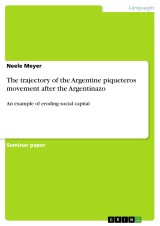Details

The trajectory of the Argentine piqueteros movement after the Argentinazo
An example of eroding social capital1. Auflage
|
15,99 € |
|
| Verlag: | Grin Verlag |
| Format: | |
| Veröffentl.: | 27.05.2013 |
| ISBN/EAN: | 9783656430803 |
| Sprache: | englisch |
| Anzahl Seiten: | 25 |
Dieses eBook erhalten Sie ohne Kopierschutz.
Beschreibungen
Seminar paper from the year 2012 in the subject Romance Languages - Latin American Studies, grade: 8,5, VU University Amsterdam (CEDLA), language: English, abstract: Ten years ago, unemployed workers movements blocking main roads in Buenos Aires became together with the middle classes’ cacerolazos the face and main forms of protest of the Argentine crisis in 2001/2002. Between the middle of the 1990s and 2001, these unemployed workers movements, the piqueteros, managed to position themselves in the center of attention of politics, media and society. At the peak moment of the crisis, the movement seemed to be unstoppable, who had a crucial impact on bringing down de La Rúa’s as well as Duhalde’s government, made efforts to coordinate different movements in the Asamblea Nacional Piquetera and was invited for talks by Nestór Kirchner as soon as he assumed presidency in 2003.
In spite of the enormous potential of the piqueteros at that point of time, the importance and support of the movement have widely diminished over the last decade − even though their original concerns, Argentina’s inequality, poverty and unemployed rates, still remain. The piqueteros’ most visible heritage, the road block, has replaced conventional strikes and is now not only used by unemployed workers movements, but by all kind of movements. It has become part of the country’s everyday life and converted Argentina into a “piquetero nation”.
In spite of the enormous potential of the piqueteros at that point of time, the importance and support of the movement have widely diminished over the last decade − even though their original concerns, Argentina’s inequality, poverty and unemployed rates, still remain. The piqueteros’ most visible heritage, the road block, has replaced conventional strikes and is now not only used by unemployed workers movements, but by all kind of movements. It has become part of the country’s everyday life and converted Argentina into a “piquetero nation”.


















